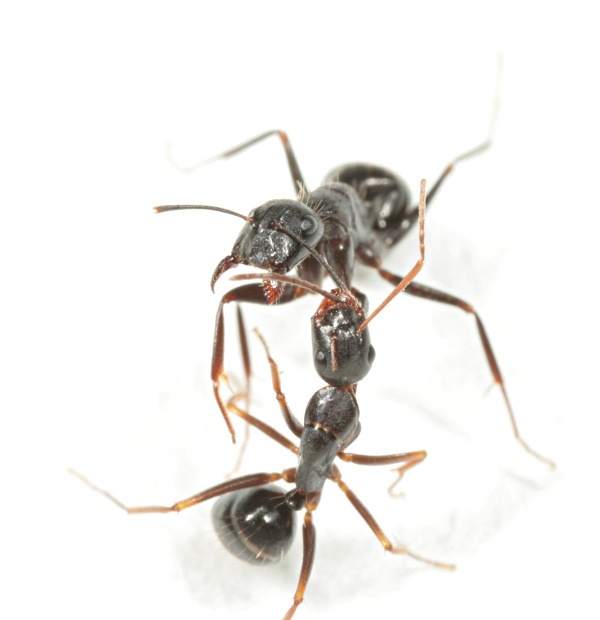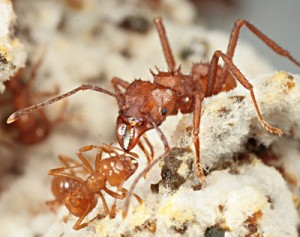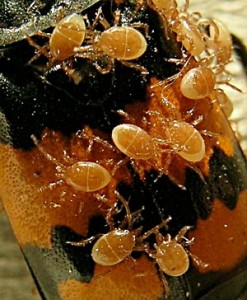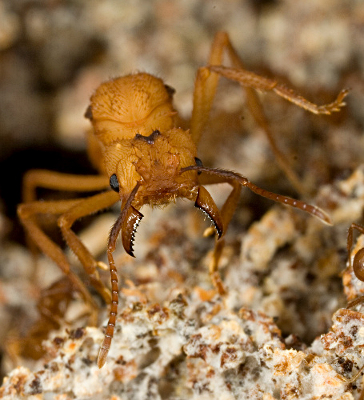Broadly summarised, we are interested in the variation in behaviour and life history, and their interaction. The success of groups, in particular of social insects, is driven by within-group division of labour. Allocating different tasks to different individuals allows for specialisation of individuals, which improves overall group performance. We study the ultimate and proximate causes and consequences of behavioural variation, mostly in ants.
Behavioural effects of variation in cue perception and processing

Ants discriminate among friends and enemies based on olfactory cues on the surface of individuals. Our previous work showed that there is significant variation in the nest defence behaviour of ant workers. The variation is caused by variation in both perception of olfactory cues and decision making (should I attack or not?). We study the proximate causes of individual variation on the perceiver side of recognition, with a particular focus on prior experience. Encounters with non-nestmates can alter later behaviour because they change alert states or neuronal templates. We analyse the effects of experience on the physiological and molecular regulation of perception and processing of olfactory cues. We manipulate the experience of individual ant workers, and make use of the natural variation in experience among ants of different ages and tasks. The project is funded by the German Research Foundation.
Senescence across the ants
Fecundity and longevity are typically traded off: Animals of most species die earlier when they produce more offspring. Social insects with their reproductive division of labour among queen and workers are a striking exception from this pattern: Queens are generally highly fecund and long-lived compared to the workers, which typically die young and do not reproduce. Theoretical models indicate that the workers’ options for direct fitness are an important factor in the selection for queen longevity. Within the framework of the research unit FOR2281 (“Sociality and the reversal of the fecundity/longevity trade-off”) we are testing this prediction and analyse the molecular networks and physiological processes that lead to the strinking ageing phenotypes across the ants. This is a collaborative project with Susanne Foitzik and Romain Libbrecht (both from Mainz), funded by the DFG.
- Majoe, M., Liebbrecht, R., Foitzik, S., Nehring, V. (2021) Queen loss increases worker survival in leaf-cutting ants under paraquat-induced oxidative stress. Philos. Trans. Roy. Soc. B. doi: 10.1098/rstb.2019.0735
- Kramer B., Nehring V., Buttstedt A., Heinze J., Korb J., Libbrecht R., Meusemann K., Paxton R.J., Séguret A., Schaub F., Bernadou A. (2021) Oxidative stress and senescence in social insects – a significant but inconsistent link? Philos. Trans. Roy. Soc. B.. doi: 10.1098/rstb.2019.0732
- de Verges, J., Nehring, V. (2016): A critical look at proximate causes of social insect senescence: damage accumulation or hyperfunction? Curr. Opin. Insect Sci. 16: 69–75. doi:10.1016/j.cois.2016.05.003 (free pdf)
Local adaptation in phoretic mites
Variation among habitats can cause differential selection on different populations of a species, leading to local adaptation of populations to their specific habitats. While the habitat variation can be abiotic, symbiotic species are exposed to additional layers of variation and may locally adapt to their symbionts. The project is tailored to assess local adaptation in the mite Poecilochirus carabi, which lives in close sympatry with Nicrophorus burying beetles. We analyse the cross-population variability of Poecilochirus mites across different geographic scales and test predictions for (co-evolutionary) local adaptation. The project is funded by the Freiburg Research Innovation Fund and the German Research Foundation (DFG).
We also investigate the sensory ecology of the mites and the chemical substances that enable them to differentiate between beetle species, using behavioural experiments and analytical chemistry methods.
- Schedwill, P., Paschkewitz, S., Teubner, H., Steinmetz, N., Nehring, V. (2020) From the host’s point of view: Effects of variation in burying beetle brood care and brood size on the interaction with parasitic mites. Plos ONE 15: e0228047. doi 10.1371/journal.pone.0228047
- Nehring, V., Teubner, H., König, S. (2019) Dose-independent virulence in phoretic mites that parasitize burying beetles. Int. J. Parasitol. 49:759-767. doi: 10.1016/j.ijpara.2019.05.011
- Schedwill, P., Geiler, A.M., Nehring, V. (2018) Rapid adaptation in phoretic mite development time. Sci. Rep. 16460.
- Nehring, V., Müller, J.K., Steinmetz, N. (2017) Phoretic Poecilochirus mites specialise on their burying beetle hosts. Ecol. Evol. 7:10743–10751. doi: 10.1002/ece3.3591
Recognition in leaf-cutting ants
Communication is the key feature of societies. Besides humans, the pinnacle of social evolution is embodied in the social insects, whose organisation is maximised by elaborate division of labour. Despite being object of intense research spanning many decades, the communication codes of social insects and their evolutionary origin are still largely unknown.
As a model system I used an ecologically tremendously successful and important group of ants, the leafcutters – which build societies of millions of workers – to find the general proximate and ultimate mechanisms underlying successful communication both at the individual and at the colony level. I also also addressed the question of whether individuals could exploit information for their personal benefit at the expense of the society. Finally, studied the adaptations that allow social parasites to break the communication code and invade leaf-cutting ant societies. I used an integrated multidisciplinary approach including , genetics, chemical analyses, and behavioural observations and experiments. Funding for my project was provided by CODICES and the German Academic Exchange Service (DAAD).
- Nehring, V., Dani, F.R., Turillazzi, S., Bohn, H., Klass, K.-D., d’Ettorre, P. (2016): Chemical disguise of myrmecophilous cockroaches and its implications for understanding nestmate recognition mechanisms in leaf-cutting ants BMC Ecol. 16: 35. doi: 10.1186/s12898-016-0089-5
- Nehring, V., Dani, F.R., Turillazzi, S.; Boomsma, J.J., d’Ettorre, P. (2015): Integration strategies of a leaf-cutting ant social parasite. Anim. Behav. 108: 55-65. doi:10.1016/j.anbehav.2015.07.009
- Larsen, J., Fouks, B., Bos, N., d’Ettorre, P., Nehring, V. (2014): Variation in nestmate recognition ability among polymorphic leaf-cutting ant workers. J. Insect Physiol. 70, 59–66. doi:10.1016/j.jinsphys.2014.09.002
- Nehring, V., Boomsma, J.J. & d’Ettorre, P. (2012): Wingless virgin queens assume helper roles in Acromyrmex leaf-cutting ants. Curr. Biol. 22: R671-R673. doi:10.1016/j.cub.2012.06.038 (press release)
- Nehring, V., Evison, S.E.F, Santorelli, L.A., d’Ettorre, P. & Hughes, W.O.H. (2011): Kin-informative recognition cues in ants. Proc. R. Soc. Lond. B 278: 1942-1948. doi: 10.1098/rspb.2010.2295 (pdf | press release)
- Fouks, B., d’Ettorre, P. & Nehring, V. (2011): Brood adoption in the leaf-cutting ant Acromyrmex echinatior : Adaptation or recognition noise? Insect. Soc. 58: 479-485. doi: 10.1007/s00040-011-0167-9. (pdf)





